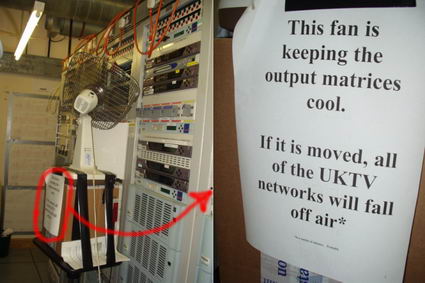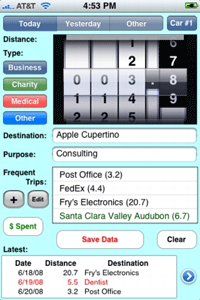Off-site SEO is More Important than On-site SEO

Don’t believe me? Ever hear of the term Google Bomb? This is where enough people point to a specific website using the same anchor text (the highlighted text that’s underlined in a link) to override what Google thinks the website is about.
The classic example is Miserable Failure which George Bush experienced a while back. Unfortunately Google has corrected this and it no longer works, so I can’t show it to you live.
But it doesn’t mean it’s not possible elsewhere. Actually it’s very possible and it happens all the time.
For example, you can have a perfectly optimized website “mesothelioma” (a renown keyword for it’s high CPC – Cost Per Click – value), but if everyone linking to your website says you’re about something else, that something else will overrule your SEO efforts. Google has realized that although you may think you about a specific topic (or maybe you’re just trying to game the system), if everyone says else wise they’re probably more accurate than you. And Google will therefore adjust what it thinks your website is about according to what everyone else says it’s about.
Which is good and bad. It means that your website can be about multiple keywords just by having links to it with different keywords. It also means that although you might optimize your website for one particular keyword, the search engines will recognize it for several other keywords which is great (assuming of course that they link to you with the other keywords).
It also means that you can get a double whammy by optimizing your website for the keyword(s) that most people link to your website for because you’ll be matching what the world thinks you’re about. That’s a good thing.
The key thing to remember is that the way people link to you is more important that your on-site SEO efforts, especially as your website gains momentum. Yes your SEO efforts are still very valuable, you will need this to be at the top of the search results. What I’m saying though is that it’s not that critical to have your website 100% SEO optimized (if that’s even possible). If you can get 70%-80% of the way there, that’s probably good enough. You’ll get to a point where you’ll be getting diminishing returns on your on-site SEO efforts, where you’d be better off spending your time getting high quality links to your website.
PS: If you’re interested in learning more about On and Off-site SEO, check out my ebook How to Generate Traffic to Your Website, in which I discuss this and many more SEO topics.
Permalink to this article Discussions (1)
Book Update: Self Published Versus POD

As most of you already know, I’m in the process of publishing a book in which I interview 40 very prominent bloggers. The project started in the winter of 2007 and we’re now near the end of the summer of 2008. I expected to have the book out by spring of this year, and summer at the latest. However most things don’t go as planned.
I initially decided to go the POD (Print on Demand) route, using iUniverse as my POD of choice. They had great reviews, a good book (Get Published!), and they seemed very knowledgeable on the phone. Again, things never quite work out as planned. iUniverse merged with AuthorHouse and Amazon has decided to change the rules for all POD publishers.
Not only that, my experience with iUniverse wasn’t all that rosy. Yes I expected some issues, but having seen them listed often as the better POD choice, I expected more from them (but then again I probably didn’t have the correct expectations). Having started the process just before the merge certainly didn’t help, especially with issues they had moving some of the staff. If memory serves me right, I went through two account managers before finally staying with Rosalie, who incidentally turned out to be the best of the three. The first account manager disappeared and it wasn’t until I called and pressed the issue that something was done. I don’t remember what happened to the second account manager, I think she decided not to move in the merger. Whatever the reasons, it took three tries which definitely delayed things.
Another issue that really irritated me was that my book was accidentally put on hold for a month. For some reason it wasn’t pushed through the next phase and it just sat there. It wasn’t until I contacted them and pushed to see what was going on that they realized the issue. Scary to think how long it could’ve been before they realized something was amiss!
On the positive side, the professional editing they provided was very good. I really believed it improved the quality of the book, so I’m pretty happy with that. However getting the editing costs all figured out was somewhat of a challenge, which I won’t go into today. Needless to say, it cost me about $1000 to get the book edited. Remember it’s an interview book so the interviews aren’t edited like a normal book (the bulk of the content), only the preface, introduction, epilogue, etc. are edited.
The downside to the editing service is that you don’t really get to communicate with the person proofreading and editing. They send you the revised document with their comments. They also include a document which adds additional comments, which by the way is filled with up-sell services (not a bad thing in of itself, but somewhat frustrating since you don’t get to actively communicate with the person). In addition, you only get one pass. And you don’t get to choose the person you’ll be working with, to see if they have the same style as you. But I got lucky and hit a good editor. Plus the amount of content was pretty small, so it wasn’t too difficult to work with.
On the negative side again, some other things started to really annoy me. For example getting the book’s cover copy (the back) took a bit more than a month. And I have to admit I wasn’t impressed with what I got back from them. Firstly, the copy was mainly an exert from one of the interviews. To me this is very weak, especially for taking a month. Anyone can just flip through a book to look at it. And if you’re shopping online you can page through a book using Amazon’s “Search Inside” feature. In their defense, they did include more than just an exert, just not much more. And it didn’t really work for me.
This led me to contact Peter Bowerman, author of The Well Fed Self-Publisher (an excellent book which I’ll discuss in more detail shortly). Through emails with Peter I decided to use his mentoring services, and am I glad I did! Although in his book he talks about self publishing versus POD, I still had to talk to him before doing a 180 degree turn and going the self publishing route. Thank you Peter! That was probably the best money I ever spent on consulting services. I don’t know that I will ever be able to beat the ROI from that one phone call!
Why did I change my mind? For a number of reasons, including those which I’ve already mentioned. But it’s more than that, and chapter 12 of Peter’s book (“Print-on-Demand (POD): Dream or Disappointment) expresses much better than I ever can. So if you’re considering either route, I strongly suggest buying his book and reading at least that chapter. It alone is worth the price of the book. And don’t get me started on Appendix C! I can’t tell you how valuable that section of the book is!
For me personally, what I didn’t like about POD is that you have no controls over timelines. There aren’t really any with POD. I could never get a good answer as to when the book would be ready, and if I did get an answer it was generally too optimistic. Plus, it was impossible to work on anything in parallel to speed up the publication of the book. For example, work couldn’t be done on the books copy and cover couldn’t be done in parallel (and each seemed to take much longer than I thought necessary – which turned out to be true). Although I didn’t agree, I accepted the sequential process at the time (mostly because I didn’t really know any better).
The catalyst though is that I couldn’t get a good idea of when the book would be ready. For the copy they said 4-5 weeks, but based on what I saw, that should have been 1-2 days. Yes they might be busy, but 4-5 weeks seems excessive. Once we agree on it, we get to move on to the cover, which I suspect will take as long if not more.
You also get very limited input in the process. For example, since I’ve gone the self-publishing route I’ve hired George Foster, one of the best book cover designers in the industry (did you know that a book is generally judged by it’s cover?). Working with George (and Peter) we came up with a general theme. Then we tweaked it several times until it was just right. This flexibility just simply isn’t available with a POD service. You don’t even get to choose the artist you’ll be working with!
The other thing that irks me is that if I’m going to pay to have someone help me with the copy (I can write web copy, but I don’t really know what sells for books) and the cover, then why am I using their service? Why do I have to wait? I’m basically paying for something I don’t want.
Something to note though about POD versus self-published, POD is significantly less expensive and less time consuming than self publishing. Self publishing is basically not for people who just want to try to write a book, it’s a full endeavor! You get what you pay for, but it’s also not cheap. So only go the self published route if you really think you have a hit on your hands (or you have a lot of money to burn). Self published is not a hobby, or a sideline like POD can be. The difference in price is from $1000-$3000 for POD to at least $10,000-$15,000 for self publishing. And this doesn’t include any time or marketing costs, this is just to get the book to out there. I’ve personally spent over $15,000 as of right now on just to get the book published. Wait until I include my marketing costs!
Before I continue, let me just say that iUniverse has its place and time. It’s just not for me. However if you plan to sell a limited number of copies, you have very limited funds, you have no timeline to get published, you don’t need creative control, or you just want to try publishing a book as a hobby, then it might be the solution for you. But for me it was no longer the right choice.
Getting back to our discussion, there are some other perks going the self published route. You own the ISBN number, not the publisher. The book is registered under your publishing company (we’ve created the entity Levac Publishing House for this first book). Plus once you get the book done, you own it. With a POD they own the finished product. For example you own the text but not the typesetting. Which means if you ever do strike out on your own, you’ll have to absorb that cost again.
But more importantly, some of the economies start to favor you with the self published model. With POD the best discount you can get for promo books is about 50% of retail, and this is only if you order in quantities of 500 or more. So if you have a $20 book, that means $5000. If you want smaller amounts, then expect only to get a 20-30% discounts. Not a small sum of money, especially if you plan to market and promote it on a commercial level. On a hobby level, you probably won’t ever need 500 promo copies. Again it depends on what you want to do.
With self publishing, you can get that cost down to $2.00 + shipping & handling (assuming an initial printing run of at least several thousand books). So assuming 500 promo books, that’s $750. Wow! What a difference from $5000! I didn’t include shipping since both options would incur this same cost. Anyways, it again comes down to your business model for the book. Is it a vanity book or are you planning on the book being a business unto itself?
Obviously you know which model I picked. I personally expect to go through more than 500 promo books in the first few months alone! I’ve already promised each interviewee a book which brings it up to 40 copies the first day.
Why is the pricing so different between the POD and self published? With POD they always charge you 50%-80% of the cost for promo books. With self publishing, once you’ve incurred the large initial upfront costs, the reproduction costs become small in comparison. In other words, you don’t make a profit for the first x books (and x isn’t a hobby number, we’re talking in the thousands of books), but once you pass that threshold (your break even number) it becomes financially viable. The statistics however show that most authors never get to the break even point. Of course for this book, we’re going to blow past the break even point!
But there’s still more. By going self published I can guarantee the quality of printing. Apparently there’s quite a few horror stories floating online about the print quality of Amazon’s new POD vendor. I’d hate to experience that.
But it doesn’t end there, there’s more. Another aspect I really like about self publishing is your ability to price your book. With POD the books generally have to sell for more because of the higher overhead. With self publishing you can generally bring your price down a bit. Not much, but about 10%-20% less. It might not seem like much, but if you’re comparing two books side by side, it might be enough to influence your decision. And more than that, the POD vendors generally set the price based on the number of pages, not the quality of the book.
So to make a long story even longer, the book’s production path has been significantly adjusted this week. A lot has changed. The title is no longer “Interview the Pros”, it’s “Blog Blazers”. It’s no longer going to be a POD book, it’s going to be a self published book. I’ve also hired an amazing team to get this book done. I’ve hired a cover artist, a book mentor, a typesetter, an indexer, and so on. Although I don’t like to promise timelines, I’m hoping to get everything to the printers by the end of next week if everything goes according to plan. From here I’ve been informed it takes about 5 weeks to print the books (a proof copy needs to be approved – with time for shipping – and then the first full run is printed and warehoused).
I would show the cover, but we’re still finalizing the last minute details. As soon as it’s ready I’ll post it up. Also the book’s website isn’t ready yet. I’m hoping to have that up very soon. I’ll keep updating you as the book is approaches the finish line.
Otherwise everthing else is progressing very fast now. I’m very excited about the results and can’t wait to see the finished and printed book!
Permalink to this article Discussions (8)
Strike One. Strike Two. Strike Three. What You're Not Out?
Recently Apple release version 2 of it’s wildly successful iPhone with great dismay. So many people flocked to the stores to buy this latest new offering that it killed their networked. This ended up causing a lot of phones to become “bricked” (aka as useful a phone as a brick). Strike 1. Well maybe not strike one, we’ll pretend they just forgot to bring their bat to the game.
Having quickly brought back their network from the dead within a day or so, people were able to activate their new iPhones (or upgrade their older iPhones to the latest software). All seemed well and rosy again.
Then within no time reports started to come out that the phones were continually crashing. That synching your phone could take hours, many hours. Daily reboots. And much worse. Basically the community came to conclusion that version 2.0.0 of the iPhone should really have been called version 2.0.0 beta (maybe even version 2.0.0 alpha depending on who you talk to).
Strike One!
Then release 2.0.1 came out. It was suppose to fix some bugs. Maybe it did, who really knows for sure. For me personally the phone was just as unstable. I think rather than 2.0.1 it should be called 2.0.0 alpha 2. In any case, at best it only seems to have resolved some superficial issues.
Strike Two!
Looks like Apple just released version 2.0.2 with even more issues. Apparently they fixed some bugs, but also introduced others. I haven’t yet upgraded myself, but if it’s anything like what’s described on this recent post on iPhone Atlas, I’m not going to either! To quote the post: “This problem is generally accompanied by another in which music and other media are erased from the iPhone.” You should see the fix to resolve this issue!
Strike Three!
What? Not out yet? Apparently not. They have enough pre-built goodwill to keep going. But for how long? No company has infinite goodwill. Eventually they’ll lose all their credibility. The “it just works” won’t apply anymore.
And it’s not like they haven’t had any time to fix these issues. It’s been what, a month? Maybe two? Yet all we seem to be getting are basic bug fixes that don’t resolve any real issues. Not only that but they seem to be causing more issues. It just works, I don’t think so.
If Apple doesn’t watch out, they’ll lose all their credibility and brand value before they know it!
Permalink to this article Discussions (0)
Why do All College Degrees Take 4 Years?

If you think about it for a moment this doesn’t make any sense at all. Really, why do all degrees take 4 years? Do all degrees require exactly the same amount of education, the same amount or learning, and the same amount of experience? It doesn’t make sense.
I won’t debate why you go to college or university, it could be to learn to learn, to acquire a skill, to acquire knowledge, to get certified, or whatever the reason. It really doesn’t matter for this post, the question is why does it take 4 years no matter what major you take?
Some topics are more involved than others. And it shows! I remember taking some harder course where each class time had a related lab time allocated to it. If you take 5 of these courses in a semester then that was 5 labs. For other subjects, there were no labs. Some classes barely even had any assignments. For example if I compare most of my computer science assignments to my psychology assignments (I majored in both), well let’s just the say the amount of effort wasn’t comparable. And most psychology classes didn’t have labs! I’m not knocking Psychology (it was my third major – I also majored in Physics), it requires a skill set that not everyone has. It’s just that the amount of effort it took me to get through my computer science classes compared to my psychology classes wasn’t even close.
Of course I assume things haven’t changed that much since I went to university, except that now laptops are standard. Back in my day, when we used to walk 50 miles in blizzards with 100mph winds, no one had a laptop in class. But seriously, I assume there’s still a large discrepancy between how much effort goes into different degrees.
And that’s how it should be. Some material is harder to learn and takes more effort. That’s life. But why is it that every college degree still takes 4 years. Why don’t they vary in time depending on what’s required?
Is it a perception thing, where people will put less value into a 2-3 year degree versus a 4-5 year degree. I’m sure that will happen, but there’s nothing wrong with that. They take differing amounts of effort.
Or is it that it’s just easier to make everyone go through the same 4 year program, and expand or shrink the effort it takes to make it fit into 4 years (not to be confused with Parkinson’s law). Plus, and I just can’t resist, it’s pretty easy money to have a 2-3 year program take 4 years.
Personally I believe the main reason is that’s easy and standard to make it 4 years, no matter how much effort it really takes. It’s the easy route. It’s the standard. Why rock the boat? And any other of the million cliches you can come up with. Sure the other benefits are nice, but I simply think it’s because that’s the way it’s always been. And that’s why we should really question why college degrees all take 4 years to complete!
Permalink to this article Discussions (5)
How to Stop People from Commenting on Your Blog?

It’s extremely easy, ask them to register!
Unless your a very large blog like lifehacker.com where you almost need to limit commenting to registered users, DON’T DO IT! You will turn off many many people.
I know I personally won’t comment on a blog that forces me to register. Why should I register? Why do I want to remember another password, especially if I might only comment once? It basically boils down to: “what’s in it for me?”
By adding a small barrier to entry, even just to reduce spam comments, you’ll significantly reduce the odds of people interacting with your blog. You’ll stunt it’s growth. You really have to ask yourself, is it worth it?
Especially if there’s really no reason for it. If because of spam, then you should really think about using this solution. YOU should be the one dealing with the spam, not your commenters. You shouldn’t be pushing this task off to your community. Especially not with all plugins available today like Akismet.
Again, and I repeat this because it’s such a simple thing to avoid, don’t force people to register to your blog to post comments. Actually if you think about, you can’t do this unless you ACTIVELY implement it. It’s not a default setting you just turn off, you need to intentionally spend time to implement this limitation.
Don’t force people to register to your blog to post comments, It’s really going to hamper your abilities to create your online community.
PS: If you’re interested in increasing the traffic to your blog, then check out my ebook How to Generate Traffic to Your Website which is available for only $14.95.
Permalink to this article Discussions (0)
How Variable Naming Can Significantly Impact Your Teams Productivity

What does kunnr mean? Anybody? If you’ve worked with SAP than you might know but to everyone else good luck. What about rqnb? Does it mean anything to you? Isn’t it obvious to you that rqnb represents a request number? Seriously though, why do people name their variables so cryptically?
Think about it a little, how much easier would the code be if the variable was named requestNumber instead of rqnb? And for those of you who think it will save a few keystrokes, hence make your typing faster, remember that each time you use the variable you have to remember how to abbreviate it. With one variable it’s not so bad, but when you have dozens, you’re always looking up the different variable names.
Still don’t believe me that it makes a large difference, tell me what the code example below does (ignoring all exception handling):
public static void chPd(uId, oP, nP)
{
Usr u = UsrDB.getPrf(uId);
if(cfPd(oP))
u.chPd(oP, nP));
}
You might have a chance with that one because it’s similar to the Unix/Linux command line tools. But what about the following more complex case:
function clcMtPy($mtAmt, $ct, $intRt, $nPt)
{
$mInt = clcMtInt($ct, $intRt);
$mPym = $mtAmt * $mInt;
if($mPym > 0)
$mPym = $mPym / (1 - pow((1 + $mInt), - ($nPt)));
return $mPym;
}
How easy was that to read? You probably didn’t get the meaning of what’s happening in the first pass, or even the nth pass. And nor should you. But that’s how a lot of code is written. What if instead it was written as:
function calculateMonthlyPayment($mortgageAmount, $country, $interestRate, $numberOfPayments)
{
$monthlyInterest = monthlyInterest($country, $interestRate);
$monthlyPayment = $mortgageAmount * $monthlyInterest;
if($monthlyPayment > 0)
$monthlyPayment = $monthlyPayment / (1 - pow((1 + $monthlyInterest), - ($numberOfPayments)));
return $monthlyPayment;
}
How much easier is that to understand? Sure in the cryptic example, once you get a good handle on what’s going on it makes sense, but how long did it take compared to the last example. And How many times did you have to re-remember which variable represented what?
Isn’t the last example much much friendlier? Couldn’t almost anyone jump in and understand right away. How much time is spent in the first two examples just understanding what’s what? And that’s with abbreviated names, what if I had just used one letter variables? Don’t get me started on that. Ever try to search for instances of a variable that’s one letter? Try searching for the variable “u” (used in the first example) on this webpage. How many hits did you get before you found it? Good luck with that!
By the way, this code is actually a real life snippet of code from our free real estate analyzer. Although our main LandlordMax application is written in Java (Swing), the free real estate property analyzer is written in PHP. Not that it really matters, this code isn’t really language dependent. (And please note that I’ve removed all code dealing with currency and doubles for clarity).
In any case, all this to say be careful when you name your variables. Don’t think in the now, think beyond. Think about tomorow and the next person. Make everyone’s lives easier. Yes it might make your code more verbose, but it also makes it readable! It’s well worth the cost.
Permalink to this article Discussions (12)
The Value of Your Brand's Credibility
Intentionally or not, every brand ends up representing certain qualities. If you follow the 22 Immutable Laws of Marketing, you can only be known for one thing, and only thing, in people’s minds. Either you’re the easiest, the fastest, the cheapest, the most luxurious, or whatever, it’s one and only one thing. Although I believe this to be true in most cases, I don’t think it’s universal to all brands. For example I believe Apple is known for two things. Apple is of course known for its innovative products like the iPhone/iTouch. But more than that, Apple is also known “to just work”.
What do I mean by “to just work”? A common belief about Apple is that their stuff just works. And right out of the box! You don’t need to spend time fixing it. You don’t have to worry about viruses. You don’t have to worry about spyware. You don’t have to worry about your computer crashing. If you buy a peripheral for your Apple computer it works. It just WORKS!
Even Apple is capitalizing on this belief. We’re all familiar with the Apple commercials with the cool hip guy talking to the older, larger, and more corporate guy discussing Apple versus Windows. And of course there’s my favorite with the Windows guy repeating himself over and over about how he’s been error free for nearly a week.
The thing to note is not whether or not this is true, but rather that it’s perceived that way by the public. It’s a common belief. You can’t argue that fact. You can argue whether or not it’s true, but you can’t argue that it’s a common belief.
Many people are buying Apple’s just to avoid dealing with issues they face on their Windows systems. Of course the issues won’t disappear, well maybe for a bit, but with time as they neglect to upgrade their machines, connect them without firewall/routers, install all kinds of crapware, the issues will come back. But ignoring that fact, the common belief out there is that Apple computers just work, and that they’re immune to all these issues. And Apple hasn’t been shy to leverage this belief.
Unfortunately however all is not rosy. With their latest release of the iPhone/iTouch software, version 2.0 (and even the recent 2.0.1 upgrade), they’ve introduced a very buggy and unstable operating system. I personally own an iTouch and upgraded mine from version 1.0 to version 2.0. I can tell you that before the upgrade I maybe rebooted once or twice in total, which is great. On the same hardware, since upgrading to version 2.0 (and 2.0.1), I can’t remember a single day I haven’t had to reboot! Wow! It’s not the hardware, it’s the operating system.
I’m by far not the only one, lots and lots of people are complaining. It’s starting to be refered to as the “White Apple Logo Screen of Death.” There are issues of random reboots. Extremely long synch ups. Network connections being dropped. Battery lives being sucked incredibly fast. Very slow UI response times at random intervals (up to ten’s of seconds where the system is locked). Complete “bricking” of the machine where you need to reset it to factory defaults which takes the better part of a day! The system completely corrupting almost every time you select “Upgrade All” for your installed apps. You name it, it’s all happening. And that’s nothing compared to the outcry from the developers!
Which leads us back to our initial question, the title of this post: What’s the value of your brand’s credibility? In other words, for a brand that’s known to “just work”, what’s going to be effect of releasing a very unstable system riddled with bugs. It will greatly affect it’s credibility, and hence it will affect its revenues. The question is how much?
Luckily for Apple they’ve got a lot of brand power when it comes to just working. This release definitely didn’t just work. There are already people comparing Apple’s latest 2.0/2.0.1 iPhone/iTouch OS to a Microsoft OS release. I can’t imagine what will happen if they call version 2.1 a service pack?. But I’m getting off topic. The question is how much will it harm their credibility of just working?
In the tech community you can generally get away with one, maybe two if you’re very lucky, bad releases assuming you’ve previously been consistently good. But you better fix those bad versions very quickly. The longer it takes to release version 2.1, the bigger the hit on their credibility.
But worse yet, Apple’s “can do no wrong” credibility has definitely been hurt. “It just works” is no longer true. They pushed out a product way before it was ready for mainstream. The common theme in the online community is that version 2.0 was barely Beta worthy.
I believe they may just get away with it this time. But they’ve just played their only “Get out of Jail Free” card which means version 3.0 had better be good. Not only that, but the upcoming 2.1 update had also better offer a significant improvement in stability otherwise there will be a lot of backlash from the community. The belief that Apple’s products “just work” will no longer hold true. And that will affect them across the board. Not just for the iPhone/iTouch, but with all their products!!!
Remember many people are buying Apple computers because they’re perceived to just work. Again, whether or not this is true doesn’t matter, the perception and reputation is there in the minds of the average consumer. And if Apple loses this, then the perceived advantage Apple has over Windows will quickly erode. It will alter the OS war in a very significant way.
Branding is important. It lets people know what you or your company is all about. Branding is what differentiates you. It’s what builds loyalty. It’s what ultimately creates your evangelists. It’s defines you in the minds of other people. If you destroy the essence of who or what you are expect there to be dire consequences. Branding takes a lifetime to build and only seconds to destroy!
Permalink to this article Discussions (3)
Penny Wise Pound Foolish

For those of you who aren’t familiar with this expression, it means to be cautious (wise) with small amounts of money but wasteful (foolish) with larger amounts of money. Does it happen often? Absolutely! I have no doubt it happens in every field and speciality, but it still amazes me just how often it happens in the IT industry.
The catalyst to this post was the recent Sophisticated Cooling Apparatus post on The Daily WTF. The picture alone says a thousand words! As you see from the picture, you have a hardware setup worth thousands, tens of thousands. Not only that, but those machines had to be configured and setup which costs time and money. And I suspect they’re also running a lot of expensive custom software.
What’s truly amazing is that the biggest failure point is a $5 used fan that’s attached with a note to not remove or unplug it because the whole system will collapse. Huh?!? A massive system with large resources (not just hardware and software, but also people) is at the mercy of a basic cheap fan! It makes no sense at all.
Which lead me to search for other examples, and it didn’t take me long at all to find many other examples. It just so happens that The Daily WTF had another article rightly entitled Penny-Wise, Pound-Foolish. And that story was even more appropriate!
In it, a bank hires a $300/hour contractor to setup monitoring software to analyze traffic on $5,000,000 worth of servers. Obviously you’d think they want to get their money’s worth from the contractor, especially at that hourly rate. You’d definitely want to give him a great computer system to work with. You’d want to completely pave the way so that he can work as efficiently as possible. Or so you would think…
Unfortunately that’s not what happened. The person got assigned a completely under-performing system that could barely run Microsoft Office! Never mind actually writing any code. So here you have someone who’s at the mercy of an obsolete computer that can barely even function. What a waste of time! Considering that a newer machine could be had for under $2000, that’s less than the consultant’s daily cost. And remember, in this scenario most of his time is sitting there waiting for the computer to just respond to a command (it had 256MB of ram – not even enough to run Windows XP).
The consultant of course complained, asking for a more powerful box. He was of course denied. He got the all too common response of “let’s make due with what we have for now”. And he’s not the only one to experience this. I’ve known many developers who’ve brought in their own hardware (including myself). This is hardware they paid for themselves! It happens too often.
And by the way the above story is even worse than my summary, but I think you get the point.
So why does it happen? And especially why does it happen so often? Because in larger companies and governments it’s all about budgets. More specifically whose budgets. For example the cost of the upgraded computer for our lowly consultant would probably be coming from another budget, one where they didn’t want to spend their money on something that didn’t give them a direct ROI. There’s no bigger picture here. It’s not like at a small startup where every penny is highly valued. It doesn’t make sense, but unfortunately that’s how the game is played.
Another possibility is the process to acquire the upgraded computer. Often in big bureaucracies it’s easier to acquire new people, even very highly paid consultants, than it is to acquire simple and cheap hardware. I’ve personally seen it many times, and I’ve heard about it even more. I remember at one time spending almost the same amount of money debating the value of getting more advanced hardware as the hardware itself cost. And it was no ones fault, that’s just how it works.
And that’s why you end up with a contractor basically being paid to sit for $300/hour. The larger bureaucracies can absorb this cost because of their size.
However all is not lost. I have a simple solution to propose. Let’s assume that not everyone is an idiot required to fill in ID-10-T forms for every little request. Let’s assume people for the most part are good and want to do a good job. Let’s TRUST people.
Instead of requiring a large process to get a computer upgrade, purchase a smaller software application, etc., let’s assume they know what they’re doing and let them do it. Give them a discretionary budget to spend on things that will make their jobs more efficient. Let them maximize their performance.
Sure some people will abuse the system, but that’s nothing compared to the state we’re in now. Using the example of the $300/hour consultant, it would take a lot, and I mean a LOT of abuse to outweigh the benefits this type of trust system would give you. Even if the consultant decided to purchase a $10k computer, the company would still be ahead!
But it gets better. Remember that for each request sent out, it has to get the approval of several people. Even that $50 stick of ram needs to be approved by several people. And a process had to be put into place. In other words, getting the approval to purchase $50 of ram probably costs a LOT MORE than the $50 stick of ram. I’d bet it easily costs over $200.
Which means that if you compare the trust system to the current system, you could technically have 4 people completely abusing the system for every real request and still come out ahead! And I don’t believe for even an instance that 400% of the requests are from people trying to abuse the system.
But wait, it doesn’t end there, you also get another great benefit. If you trust people they will be more productive. Not only are you saving money, you’ll get better results. People who are trusted are more motivated. When you have a good team that gels well together, they can do great things. If you embody distrust and bureaucracy, well things come to a crawl and any and all motivation slowly dwindles to nothingness.
Trust your people. The results might surprise you.
Permalink to this article Discussions (0)
50% Discount on How to Generate Traffic Ebook!
Ever since the ebook appeared on Bits du Jour, I’ve been considered reducing the price by 50%. I also have to admit I just haven’t had the appropriate time to allocate to marketing the book, what with Interview the Pros (the traditionally published book I have coming out soon) and the upcoming major release of LandlordMax.
In any case, I’ve just reduced the price of the ebook by 50% tonight. I’m going to give that a try, at least for now. I don’t know how long it will last, so if you’ve been on the fence nows a good time to take advantage of this offer. I definitely will never reduce the price lower than it is today. If anything else, once I have some time to really market it, the price will likely increase.
Considering how affordably priced I thought it was before, now it’s an even greater deal. It’s now less than the price of going to a movie with a popcorn and drink!!! You can’t beat that. Check it out now!
Permalink to this article Discussions (2)
Why Have a Start Button to Shutdown Windows?

The other day I was watching David Pogue’s presentation When it comes to tech, simplicity sells on Ted Talks about good and bad UI design, which overall was very good. However good UI (User Interface) design is not always as obvious as he makes it out to be, and sometimes it’s even very counter-intuitive.
For example, it’s very easy to bash Microsoft Windows. Not that I’m a “fanboy” of any particular operating system, at LandlordMax we work with Microsoft Windows, Mac OS, and Linux, so I’m pretty operating system agnostic. In any case, David presented some good examples of good and bad UI design, and in most cases he was 100% right. In one comparison, for example, he compared the difference between the shutdown menus on Windows and the Mac OS. The Mac OS definitely had a more obvious and easier user interface.
What got my attention however, and the reason I’m writing today, is that he also made a passing joke about Windows and how you shut it down. He said “Why in gods name do you shutdown a Windows PC by clicking on a button called Start” (approx 11 minutes into the presentation) which drew some laughter from the audience. I agree his comment makes sense intuitively, but he’s unfortunately wrong in this case.
Raymond Chen writes about Microsoft’s decision to use the “Start” button in his book The Old New Thing. It’s too bad David hasn’t read Raymond’s book or blog post about the decision to use the Start button. Basically it goes that in the beginning of Windows there was no “Start” button, they only added it after going through some usability testing.
To quote Chen (the highlights are my own):
Back in the early days, the taskbar didn’t have a Start button. (In a future history column, you’ll learn that back in the early days, the taskbar wasn’t called the taskbar.)
Instead of the Start button, there were three buttons in the lower left corner. One was the “System” button (icon: the Windows flag), one was the “Find” button (icon: an eyeball), and the third was the “Help” button (icon: a question mark). “Find” and “Help” are self-explanatory. The “System” button gave you this menu:
Run…
Task List…
Arrange Desktop Icons
Arrange Windows 4
Shutdown Windows(“Arrange Windows” gave you options like “Cascade”, “Tile Horizontally”, that sort of thing.)
Of course, over time, the “Find” and “Help” buttons eventually joined the “System” button menu and the System button menu itself gradually turned into the Windows 95 Start menu.
But one thing kept getting kicked up by usability tests: People booted up the computer and just sat there, unsure what to do next.
That’s when we decided to label the System button “Start”.
It says, “You dummy. Click here.” And it sent our usability numbers through the roof, because all of a sudden, people knew what to click when they wanted to do something.
So why is “Shut down” on the Start menu?
When we asked people to shut down their computers, they clicked the Start button.
Because, after all, when you want to shut down, you have to start somewhere.
(Besides, if we also had a “Shut down” button next to the Start button, everybody would be demanding that we get rid of it to save valuable screen real estate.)”
The morale of the story, be careful before you start trashing user interfaces, there might just be a reason for some odd solutions.

And this was proved again recently in the post Learning from “bad” UI on Signal Versus Noise when Ryan walked us through the UI design of TripLog/1040. This UI at first seems to be horribly designed, with no thought at all given to it. But once you understand the reasoning and usability behind it, you quickly realize that it was indeed very well designed and that a LOT of thought was actually given to the design of its UI!
Of course many UI’s are just badly designed, there’s no question about it. It’s just that sometimes the obvious is not so obvious!
Permalink to this article Discussions (12)





